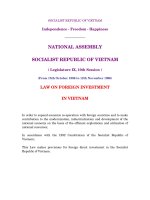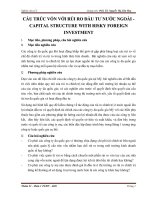Capital investment appraisal 3
Bạn đang xem bản rút gọn của tài liệu. Xem và tải ngay bản đầy đủ của tài liệu tại đây (783.09 KB, 67 trang )
Chapter 14
Capital Investment Appraisal
Capital investment appraisal
Capital investment involves the sacrifice of current
funds in order to obtain the benefit of future wealth.
It involves investing now in the hope of generating
future cash flows which will exceed the initial
investment.
Investment in capital projects involves large initial
financial outlays, with long waiting periods before
these funds are repaid from future cash flows or
profits.
Features of capital investments
Capital investment involves the use of significant
levels of finance to acquire assets for long-term
use in an organisation with the desire to
increase future revenues and profits.
Capital investment decisions
The decision to charter or purchase an aircraft.
The decision to lease or buy property to open a retail outlet, restaurant,
leisure centre or other such business.
The decision to install an energy saving control system within a
property.
The decision to extend or refurbish a hotel, pub, restaurant or retail
outlet.
The decision to develop leisure or conference facilities within a hotel.
The decision to invest in a central reservations computer system in a
hotel.
The decision to employ a computerised point of sales stock control
system in a retail chain.
The decision to purchase new fun activities equipment within a leisure
park.
The decision by a catering firm to purchase more equipment in order to
tender for a school meals contract.
Features of capital investment
decisions
The sums involved are relatively large.
The timescale over which the benefits will be received is
relatively long, with greater risks and uncertainty in forecasting
future revenues and costs.
The nature of a business, its direction and rate of growth is
ultimately governed by its overall investment programme.
The irreversibility of some projects due to the specialised nature
of certain assets for example, some plant and machinery bought
with a specific project in mind could have little or no scrap value.
In order to complete projects on time and within budget,
adequate continuous control information is required.
Capital investment is long-term and the recoupment of
investment may involve a significant period of time.
Factors to consider in assessing
capital projects
The size of the investment.
The phasing of the investment expenditure.
The period between the initial investment and the
asset actually generating revenues and profits for the
business.
The economic life of the project.
The level of certainty regarding the projected cash
flows.
The working capital required.
The degree of risk involved in the project.
Capital appraisal methods
As capital investment decisions usually involve
significant amounts of finance, it is important to
fully evaluate each decision using sound
appraisal techniques. The main methods used
to evaluate investment in capital projects are:
Accounting rate of return.
Payback method.
Net present value.
Internal rate of return.
Capital appraisal methods
Accounting Rate of Return (ARR)
Profits
Payback
Cash flows
Net Present Value (NPV)
Cash flows
Internal Rate of Return (IRR)
Cash flows
Capital appraisal methods
The accounting rate of return is based on the use of operating
profit. The operating profit of a project is the difference
between revenues earned by the project, less all the operating
costs associated with the project, including depreciation.
All other appraisal methods use net cash flows as the basis for
appraising capital projects. This is due to the nature of
assessing capital investment projects where one must spend
cash now and reap the cash rewards later.
The calculation of accounting profit is not concerned with the
timing of cash flows. This is due to its adherence to the
accruals concept whereby profits are calculated by deducting
expenses charged from revenues earned.
Net cash flow
Net
Net cash
cash flow
flow ==
operating
operating cash
cash flows
flows ++ // -- capital
capital cash
cash flows
flows
Net profit and net cash flow
Net profit
Net cash flow
Related revenue earned
less
Related cash inflows (operating +
capital)
less
All related costs
(including depreciation)
equals
Related cash outflows (operating
+ capital)
(NOT including depreciation)
equals
Profit
Net cash flow
Accounting rate of return (ARR)
The accounting rate of return method calculates the
estimated overall profit or loss on an investment project
and relates that profit to the amount of capital invested
and to the period for which it is required.
A business will have a required minimum rate of return
for any investment. This is related to the cost of capital of
the business.
If an investment yields a return greater than the cost of
capital, then the investment would be considered suitable
and profitable.
The accounting rate of return is an average rate of return
calculated by expressing average annual profit as a
percentage of the average value of the investment.
Accounting rate of return (ARR)
ARR = Average annual profit
Average investment
Average annual profit
Total
project
profit
after
depreciation and before interest,
tax and dividends, divided by the
estimated life of the project.
Average investment
Initial investment, plus value of
investment at project-end, divided
by two.
Example 14.1: Accounting rate of
return
Example 14.1: Accounting rate of
return
Accept or reject criteria for ARR
method
Accept the project
Reject the project
Project ARR greater
than the minimum
required return.
Project ARR less than
the minimum required
return.
Advantages of ARR
It takes account of the overall profitability of the
project.
It is simple to understand and easy to use.
Its end result is expressed as a percentage, allowing
projects of differing sizes to be compared.
Disadvantages of ARR
It is based on accounting profits rather than cash
flows.
The ARR does not take into account the timing of
cash flows.
The ARR does not take into account the time value of
money. It does not take into account the cost of
waiting to recoup the investment.
The ARR takes no account of the size of the initial
investment.
The payback method
This method of investment appraisal simply asks
the question ‘how long before I get my money
back?’
How quickly will the cash flows arising from the
project exactly equal the amount of the
investment.
It is a simple method, widely used in industry and
is based on management’s concern to be
reimbursed on the initial outlay as soon as
possible.
It is not concerned with overall profitability or the
level of profitability.
Example 14.2: Payback
Example 14.2: Payback
Accept or reject criteria for
payback method
Accept the project
Reject the project
Payback period is less than
that required by investors.
Payback period is greater
than that required by
investors.
Advantages of payback
It is simple to understand and apply.
It promotes a policy of caution in investment.
Disadvantages of payback
It takes no account of the timing of cash flows (€100
received today is worth more than €100 received in
12 months time).
It is only concerned with how quickly the initial
investment is recovered and thus it ignores the overall
profitability and return on capital for the whole project.
Time value of money
The time value of money concept plays an important
role in appraising capital projects because the time
lag between the initial investment and payback can
be quite long.
€1 earned or spent sooner, is worth more than €1
earned or spent later.
To evaluate any project taking into account the time
value of money, the cash flows received in the future
must be reduced or discounted to a present value, so
that all relevant cash flows are denominated in todays
value (present value).









